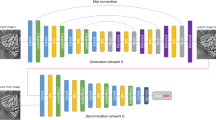Abstract
In previous research on ghost imaging encoding transmission schemes, the influence of real transmission channels on the communication quality was weakened to some extent. Simultaneously, to ensure the imaging quality of the algorithm, it is often performed under full sampling or even supersampling, which undoubtedly requires a long sampling time. This paper proposes a ghost imaging reconstruction method that uses a generative adversarial network and Rayleigh fading channel. By introducing the channel transmission model (Rayleigh fading channel) in real scenes and the generative adversarial neural network model, the image is reconstructed under under-sampling and the imaging time is saved. To further explore how to improve the image transmission quality and reduce the channel interference as much as possible, this scheme provides a new imaging technology for the research of the image transmission field, which has good theoretical significance.







Similar content being viewed by others
Explore related subjects
Discover the latest articles and news from researchers in related subjects, suggested using machine learning.Data availability
No datasets were generated or analyzed during the current study.
References
Liao, R., Wen, H., Wu, J., et al.: The Rayleigh fading channel prediction via deep learning. Wirel. Commun. Mob. Comput. 2018, 6497340 (2018)
Mallik, R., Murch, R.: Rayleigh fading channel capacity for coherent signaling with asymmetric constellations. IEEE Trans. Commun. 70(4), 2342–2357 (2022)
Gong, X., Zhu, Q.: Modulation recognition based on SVM in fading channels. Signal Process. 26(8), 1234–1239 (2010)
Li, Y., Li, B., Liu, M.: Algorithm for blind identification of MQAM signals in Rayleigh fading channels. J. Huazhong Univ. Sci. Technol. 40(4), 76–79 (2012)
Zhu, H., Zhang, T., Wang, Z., et al.: Algorithm for modulation recognition based on cumulants in Rayleigh channel. J. Comput. Appl. 33(10), 2765–2768 (2013)
Wang, A., Li, L.: Underground signal recognition method based on higher-order cumulants and DNN model. Indus. Mine Automat. 46(2), 82–87 (2020)
Wang, T., Chen, M., Wu, H., et al.: Underwater compressive computational ghost imaging with wavelet enhancement. Appl. Opt. 60(23), 6950–6957 (2021)
He, Y., Zhang, A., Yu, W., et al.: Energy-selective x-ray ghost imaging. Chin. Phys. Lett. 37(4), 044208 (2020)
Donoho, D.: Compressed sensing. IEEE Trans. Inf. Theory 52(4), 1289–1306 (2006)
Zhang, H., Xia, Y., Duan, D.: Computational ghost imaging with deep compressed sensing. Chin. Phys. B 12, 513–517 (2021)
Wang, L., Zhao, S.: Compressed ghost imaging based on differential speckle patterns. Chin. Phys. B 29(2), 7 (2020)
Wan, W., Luo, C., Guo, F., Zhou, J., Wang, P., Huang, X.: Demonstration of asynchronous computational ghost imaging through strong scattering media. Opt. Laser Technol. 154, 108346 (2022)
Sui, L., Pang, Z., Cheng, Y., et al.: An optical image encryption based on computational ghost imaging with sparse reconstruction. Opt. Lasers Eng. 143(7), 106627 (2021)
Komuro, K., Nomura, T., Barbastathis, G.: Deep ghost phase imaging. Appl. Opt. 59(11), 3376–3382 (2020)
Wu, H., Wang, R., Zhao, G., et al.: Deep-learning denoising computational ghost imaging. Opt. Lasers Eng. 134, 106183 (2020)
Liu, S., Meng, X., Yin, Y., et al.: Computational ghost imaging based on an untrained neural network. Opt. Lasers Eng. 147, 106744 (2021)
He, X., Zhao, S., Wang, L.: Handwritten digit recognition based on ghost imaging with deep learning. Chin. Phys. B 30(5), 6 (2020)
Mirza, M., Osindero, S.: Conditional generative adversarial nets. Comput. Sci. 17(84), 2672–2680 (2014)
Radford, A., Metz, L., Chintala, S.: Unsupervised representation learning with deep convolutional generative adversarial networks. OALib J. 64(34), 1–15 (2015)
Arjovsky, M., Chintala, S., Bottou, L.: Wasserstein Gan[J]. arXiv preprint, (2017),78 (75): 1–30.
Wang, X., Yu, K., Wu, S., et al.: Enhanced super-resolution generative adversarial networks. Eur. Conf. Comput. Vision 1(23), 63–79 (2019)
Ye, H., Guo, D.: Research on mechanism of joint-coding imaging based on generative adversarial neural network. Opt. Lasers Eng. 171, 107790 (2023)
Ye, H., Zhang, L., Chen, J., et al.: Information transmission based on a fourier transform and ascending coding temporal ghost imaging algorithm. Laser Phys. 30(12), 125202 (2020)
Ye, H., Kang, Y., Wang, J., et al.: High-resolution reconstruction method of ghost imaging via SURF-NSML. J. Korean Phys. Soc. 80, 964–971 (2022)
Ye, H., Kang, Y., Wang, J., et al.: A ghost imaging method based on multi-frequency fusion. Eur. Phys. J. D 76(3), 48 (2022)
Chow, Y., Susilo, W., Wang, J., et al.: Utilizing QR codes to verify the visual fidelity of image datasets for machine learning. J. Netw. Comput. Appl. 173, 102834 (2021)
Acknowledgements
The authors are indebted to the anonymous referees for their instructive comments and suggestions. We are very thankful for the participants for their support and contribution to this study.
Author information
Authors and Affiliations
Contributions
We are very thankful for the participants for their support and contribution to this study. Ye Hualong designed the study and collected data. Guo Daidou provided the software platform for this experiment. Ye Hualong and Guo Daidou analyzed data and wrote the paper. Ye Hualong and Guo Daidou and Xu Tongxu revised the paper. We declare that we have no financial and personal relationships with other people or organizations that can inappropriately influence our work, there is no professional or other personal interest of any nature or kind in any product, service and/or company that could be construed as influencing the position presented in, or the review of, the manuscript entitled.
Corresponding author
Ethics declarations
Conflict of interest
The authors declare no competing interests.
Additional information
Publisher's Note
Springer Nature remains neutral with regard to jurisdictional claims in published maps and institutional affiliations.
Rights and permissions
Springer Nature or its licensor (e.g. a society or other partner) holds exclusive rights to this article under a publishing agreement with the author(s) or other rightsholder(s); author self-archiving of the accepted manuscript version of this article is solely governed by the terms of such publishing agreement and applicable law.
About this article
Cite this article
Ye, H., Xu, T. & Guo, D. Research on ghost imaging reconstruction by generative adversarial network and Rayleigh fading channel. Quantum Inf Process 24, 88 (2025). https://doi.org/10.1007/s11128-025-04701-0
Received:
Accepted:
Published:
DOI: https://doi.org/10.1007/s11128-025-04701-0




